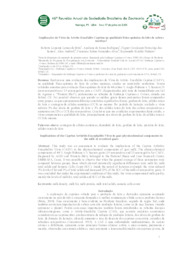Implicações do Vírus da Artrite-Encefalite Caprina na qualidade físico-química do leite de cabras mestiças.
Implicações do Vírus da Artrite-Encefalite Caprina na qualidade físico-química do leite de cabras mestiças.
Author(s): BRITO, R. L. L. de; RODRIGUES, A. de S.; SANTOS, F. C. P. dos; ANDRIOLI, A.; ALVES, F. S. F.; PINHEIRO, R. R.
Summary: Resumo: Realizou-se uma avaliação das implicações do Vírus da Artrite- Encefalite Caprina (CAEV), na qualidade físico-química do leite de cabras mestiças, criadas no semi-árido nordestino. Foram coletadas amostras para avaliação físico-química do leite de 44 cabras ½ Anglo-Nubiana x ½ Saanen (19 eram soropositivas e 25 soronegativas para o CAEV, diagnosticadas pelo teste de Imunodifusão em Gel de Agarose e (Western Blot), pertencentes ao rebanho da Embrapa Caprinos e Ovinos, situada em Sobral, CE. Foi possível observar que quando as médias gerais desses parâmetros foram comparados entre grupos, os que apresentaram diferença estatística significativa foram: gordura do leite, sólidos totais do leite e contagem de células somáticas (CCS) no mesmo. No período de lactação avaliado o vírus reduziu 5% dos níveis de gordura do leite e 3% dos sólidos totais do leite das cabras soropositivas e aumentou em 32% a CCS das soropositivas. Concluí-se que nas condições experimentais deste estudo, o vírus comprometeu a qualidade do leite, principalmente nos níveis de gordura do leite, de sólidos totais e CCS do mesmo. Implications of the Caprine Arthritis-Encephalitis Virus in goat physicochemical components in the milk of crossbred goats] Abstract: This study was an assessment to evaluate the implications of the Caprine ArthritisEncephalitis Virus (CAEV) in the physicochemical components of goat milk. The physicochemical components of 44 ½ Anglo-Nubiana x ½ Saanen goats (19 seropositive and 25 seronegative for CAEV, diagnosed by AGID and Western Blot), belonged to the National Sheep and Goat Research Center, EMBRAPA, Ceara. It was possible to observe that when the general average of these parameters were compared between groups, those which showed statistically significant differences were milk fat, milk total solids and Somatic Cells Count (SCC). Inside the period of lactation evaluated, the virus reduced 5% levels of fat and 3% of total solids and increased 32% of the SCC of the milk of seropositive goats. It was concluded that under the experimental conditions of this study, the virus compromised milk quality, mainly the levels of milk fat, total solids and SCC of the milk.
Publication year: 2009
Types of publication: Paper in annals and proceedings
Unit: Embrapa Goats & Sheep
Keywords: Brazil, CAEV, Cabra Leiteira, Caprine arthritis encephalitis virus, Caprino, Caprino leiteiro, Contagem de células somáticas, Densidade do leite, Doença Animal, Goat diseases, Goat milk, Goats, Gordura Láctea, Gordura do leite, Leite de Cabra, Milk density, Milk proteins, Milk total solids, Proteína do leite, Somatic cells count, Sólidos totais do leite, Vírus da artrite-encefalipe caprina
Observation
Some of Embrapa's publications are published as ePub files. To read them, use or download one of the following free software options to your computer or mobile device. Android: Google Play Books; IOS: iBooks; Windows and Linux: Calibre.
Access other publications
Access the Agricultural Research Database (BDPA) to consult Embrapa's full library collection and records.
Visit Embrapa Bookstore to purchase books and other publications sold by Embrapa.

